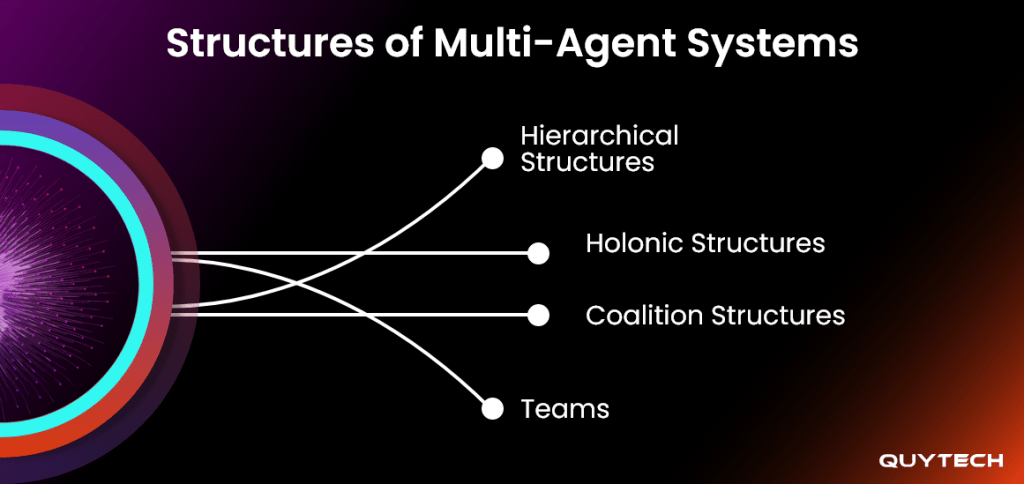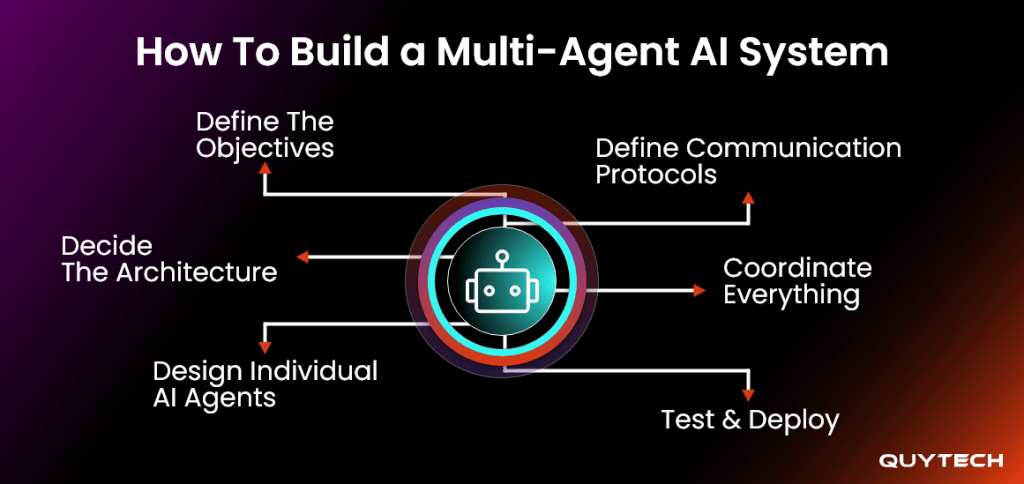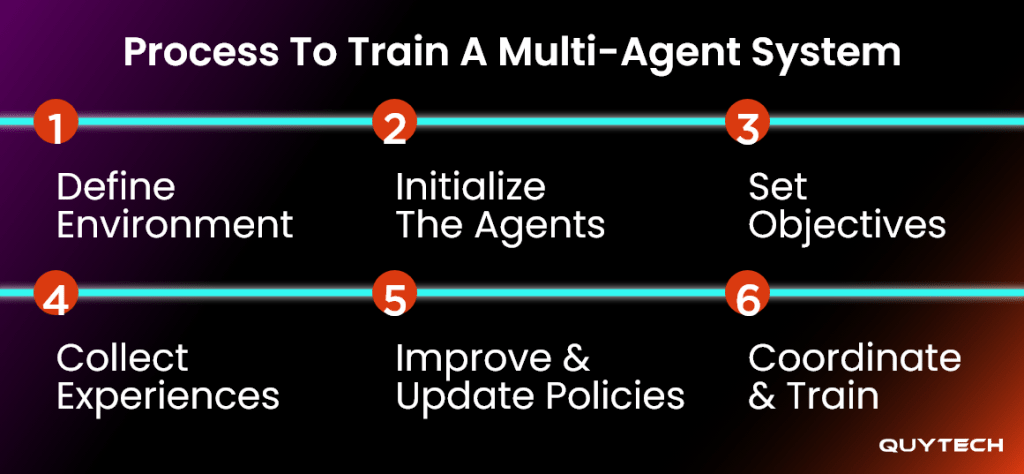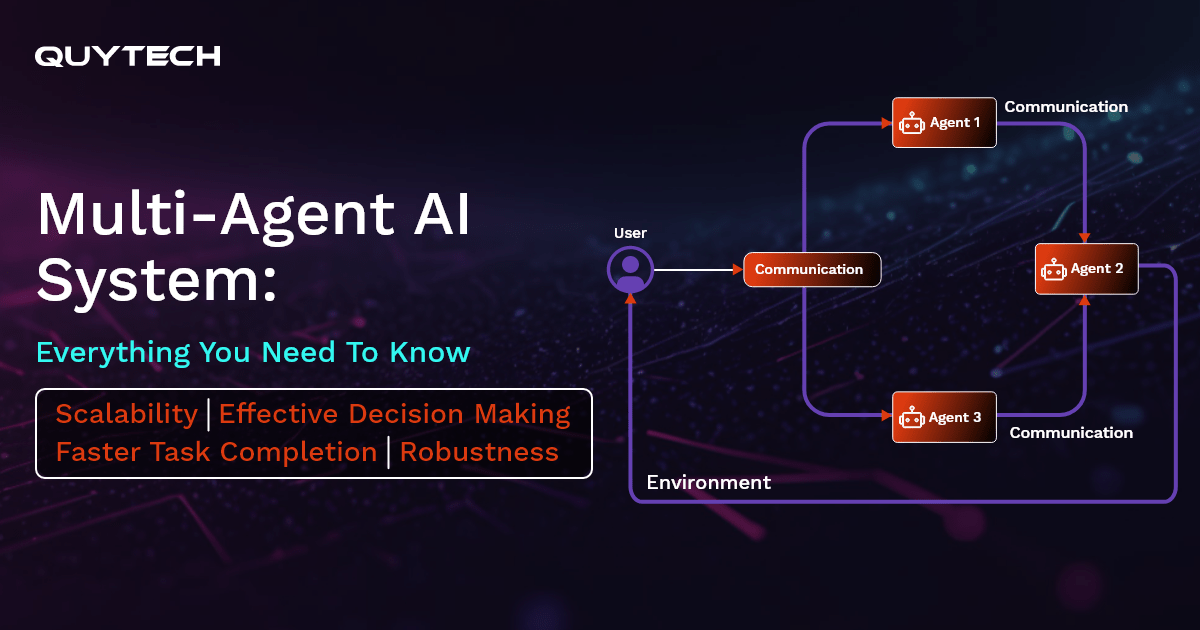Multi-agent systems are subsets of AI agents. They stand out from other agents with their ability to handle complex tasks with ease. These agents make informed decisions for themselves to carry out assigned tasks efficiently.
Multi-agent systems bring in a blend of technologies, like LLM models, reinforcement learning, deep learning, communication protocols, and many more. These technologies make these agents capable of working collaboratively without conflicts. But how exactly do these systems help a business?
If you’re curious about multi-agent systems, then this blog is for you. We have covered everything you need to know about multi-agent systems.
Key Takeaways
- Multi-agent system is a type of AI agent where multiple independent AI agents work collaboratively to achieve a combined objective.
- The core components of a multi-agent system include environment, agents, actions, rewards, and communication channels.
- The architecture of the multi-agent systems can be categorized into centralized, decentralized, and hybrid networks. Along with these, the structures can be classified into hierarchical, holonic, coalition, and team.
- The development process incorporates objective determination, architecture decision, agent development, communication protocol decision, coordination, testing, and deployment.
- The process of training a multi-agent system starts by building the environment, setting goals, letting agents interact, learning from outcomes, refining policies, and training until they perform effectively.
What Exactly are Multi-Agent AI Systems?
Before we go into detail about a multi-agent system, let’s first get a basic grasp of AI agents. An AI agent is a system that independently performs the tasks assigned to it. This means that it is capable of making its own decisions, planning actions, and executing them.
Now, when it comes to a multi-agent system, the first thing that rings a bell is the name itself. Multi-agent system implies that it comprises multiple AI agents working collectively. All these agents are autonomous. They have their skills and are capable of making decisions for their tasks.
What brings a difference here is that these AI agents work collaboratively. They have different tasks, but these tasks are all connected to achieve a certain objective. This objective is usually complex and cannot be carried out by single agents, hence calling for multi-agent systems.
Core Components of Multi-Agent Systems
Now, when we talk about the core components of multi-agent systems, the first one that comes to mind is the agent itself, followed by the environment and the communication protocols. Let’s take a quick look at this:
| Aspect | Agents | Environment | Communication Protocols |
| Definition | Agents are independent entities that have certain roles assigned. | The environment is the ecosystem where all the agents interact and collaboratively work. | Communication protocols are the rules that they follow to connect and work effectively. |
| Purpose | Agents serve their purpose by completing the tasks assigned to them. They can make their plans and decisions to efficiently accomplish their assigned work. | The environment serves as a medium for the agents to work in and interact. This is where the agents acquire their resources to work from. | The purpose of communication protocols is to provide rules that guide the communication process. It makes agent-to-agent communication clear. |
Similar Read: Top 10 AI Agents in 2025
Architecture of Multi-Agent Systems
(diagram type)
The architecture of multi-agent systems in artificial intelligence can be classified into:
- Centralized Networks
- Decentralized Networks
- Hybrid Networks
Centralized Network
- In centralized networks, there is one central agent that has all the resources. The agents derive these resources to complete their tasks. Since there is a central unit, it’s clear that all agents acquire knowledge from the central base.
- Centralized networks are easy to design and ensure easy collaboration.
- Like everything else, the centralized network has its limitations too. Being directed by the central agent, if it unit fails, all the agents fail.
Decentralized Networks
- In the decentralized model, the agents interact with their peer agents to share information. There is no central agent, so the knowledge here is gathered by communicating with neighbouring agents.
- Decentralized networks are very robust. Even the failure of one agent doesn’t affect the rest.
- Since the system relies a lot on communication, it’s obvious that it requires complex communication protocols.
Hybrid Networks
- The hybrid network is a blend of both centralized and decentralized networks. It utilizes the centralized networks when working on complex tasks. And chooses decentralized networks when flexibility is needed.
- Its blended approach enables a smooth switch in control and flexibility based on tasks assigned.
- Being a mix of two different networks, its design and implementation process are quite complex.
Structures of Multi-Agent Systems
The structures of multi-agent systems can be divided into:

Hierarchical Structures
As the name implies, the hierarchical structure follows a hierarchy. The hierarchy consists of supervising agents and subordinate agents. The supervising agents divide tasks among the subordinate agents.
Following a hierarchical structure means that the roles are clearly defined, resulting in easy management. The limitation here is that if the supervising agents fail to perform due to overburden, then the whole system’s performance will be affected.
Holonic Structures
In holonic structures, various wholes together constitute a bigger whole. From a broader perspective, the setting may seem like an agent working, but it actually is a group of agents working together.
Holonic structure brings in easy scalability along with robustness. The limitation in this structure can be the complexity of creating the boundaries and assigning the roles without overlapping.
Coalition Structures
The coalition structure works like a group of friends. They join in together whenever there is a drop in performance on any agent. Once the performance comes to a level, they go back to work individually.
This structure boosts efficiency and effectively utilizes resources. The disadvantage in coalition structure can be he extra time and effort that the agents spend to create or disband a group.
Teams
The team structure, as is obvious, creates a team with very little touch of hierarchy. What makes this different from a coalition is that this structure is not for short periods.
This structure brings smooth coordination as teams work systematically and collaboratively. The limitation here is that teams are very interdependent. One failing agent can impact all others.
You might also like: How to Create an AI Agent? Top Use Cases and Benefits
How to Build a Multi-Agent AI System
Ready to build a multi-agent system of your own? Follow this step-by-step development process of multi-agent AI systems:

Step 1: Define the Objectives
In this stage, you will decide the objective of building a multi-agent system. This includes identifying the solution your system will provide, along with deciding the task that you want each agent to perform.
Step 2: Decide the Architecture
Decide on the architecture and structure that you want to incorporate into your system. You can choose from centralized, decentralized, or hybrid architectures. For structures, you can consider one of the options based on your needs.
Step 3: Design Individual AI Agents
After you have decided on the architecture, start designing the multi-agent system. Decide on the type of agents you want, like reactive agents, learning agents, collaborative agents, and so on.
Step 4: Define Communication Protocols
Single multiple agents collaboratively work in a multi-agent setting; defining the communication protocol is important. Define how the agents will contact each other, share information, language for the purpose, etc.
Step 5: Coordinate Everything
Coordinate the agents based on the architecture and structure of the multi-agent system. Assign roles, decide when certain agents will work, and how they will do so. Integrate conflict-solving rules so that the coordination remains unaffected even if conflicts arise.
Step 6: Test & Deploy
Test the agents and their working mechanisms rigorously. Identify bugs and fix them. Once the outcome matches the planned performance of the multi-agent system, deploy it. Keep improving over time and provide post-deployment maintenance as well.
Similar Read: AI Agents in E-Commerce: Everything You Need to Know
Process to Train a Multi-Agent System
Multi-agent systems need proper training to enhance decision-making and handle complex situations; understanding their training process is key. Let’s quickly guide you through the process of training a multi-agent system:

- Define Environment
Set up the ecosystem where agents will connect, including the rules and the rewards.
- Initialize the Agents
Design each agent with its decision-making process or policies.
- Set Objectives
Decide how the agents will work; it can be to collaborate, share information, or compete with each other.
- Collect Experiences
Let the agents interact with each other and collect those experiences for analysis.
- Improve and Update Policies
If you find any setbacks in their interaction process, update and improve the policies.
- Coordinate and Train
Coordinate, train, and improve the agents till they perform as planned.
Advantages of Using Multi-Agent AI
Now let’s explore the advantages of using multi-agent AI systems:

Scalability
The multi-agent AI systems are scalable. They can easily tackle complex and large problems by deploying agents accordingly. This makes the process of handling multiple tasks at one time efficient.
Effective Decision Making
In a multi-agent system, different agents make decisions suitable for their line of tasks. This ensures that every agent takes calculated decisions for themselves, along with smooth collaboration.
Faster Task Completion
Unlike single-agent systems, where one agent does it all, a multi-agent system does the same but divides tasks among many agents, resulting in faster completion.
Robustness
Multi-agent systems are very robust. They don’t depend on a single agent for all the tasks. This means that multiple agents complete a task, so even if one agent fails or stops working, others cover for it.
Effective Resource Utilization
Multi-agent AI systems effectively utilize the resources. They do not waste time and effort gathering information about the same task. They are capable of sharing it amongst themselves.
Use Cases of Multi-Agent AI
Let’s discover some use cases of multi-agent AI systems:

Healthcare
- In healthcare, multi-agent systems help in planning treatment based on test results and lab reports.
- Helps in monitoring patients with the help of agents on wearable devices
Finance & Banking
- Multi-agent system in finance and banking works by automating trading.
- It assists in tasks like loan approvals by analyzing credit scores, income reports, etc.
Retail & E-commerce
- In retail and e-commerce, multi-agent AI systems personalize recommendations based on customers’ purchase history and behaviour.
- They also manage inventory levels based on forecasted demand.
Manufacturing
- Multi-agent systems in manufacturing predict maintenance needs to avoid downtime caused by sudden breakdowns.
- They manage supply chains for smooth production processes.
Education & Training
- In the education sector, multi-agent AI systems manage virtual classrooms for students.
- Multi-agents also help in providing real-world scenarios to train students for certain situations.
You Might Also Like: Types of AI Agents: Use Cases, Benefits, and Challenges
How Quytech Delivers Value with Multi-Agent AI
Quytech plays the role of a technology partner that not just understands your ideas but also turns them into reality. Our 14+ years of industry experience and varied domain exposure have enabled us to thoughtfully deliver customized multi-agent solutions. We have delivered successful AI agent-based projects like E-commerce AI agent, Healthcare AI agent, and many more.
Quytech excels at delivering multi-agent system solutions that are easily scalable and tailored to your business. Our dedicated developers closely communicate with you throughout the process of development, ensuring transparency and trustworthiness.
Conclusion
Multi-agent systems are so independent and capable that they can truly be called a futuristic technology. They bring in a perfect blend of technology that imitates human effort but completes the tasks quickly.
With benefits like easy scalability, flexibility, quick task completions, and efficient resource utilization, Multi-agent systems not only spark a transformation through automation but also bring operational efficiency. In conclusion, we can say that multi-agent systems are a worthwhile investment.
FAQs
Yes, multi-agent systems can be customized for your business. The customization part can be done to make agents specialized in specific tasks.
Multi-agent systems in artificial intelligence are very scalable. You can begin with a smaller number and scale as needed without having to train them all over again.
Yes, you can implement a multi-agent system in your business without a tech team, too, by hiring developers or partnering with an AI agent service provider.
The cost of multi-agent planning in artificial intelligence depends on the complexity, scalability, and customization factors. Simpler multi-agents are comparatively less expensive.



